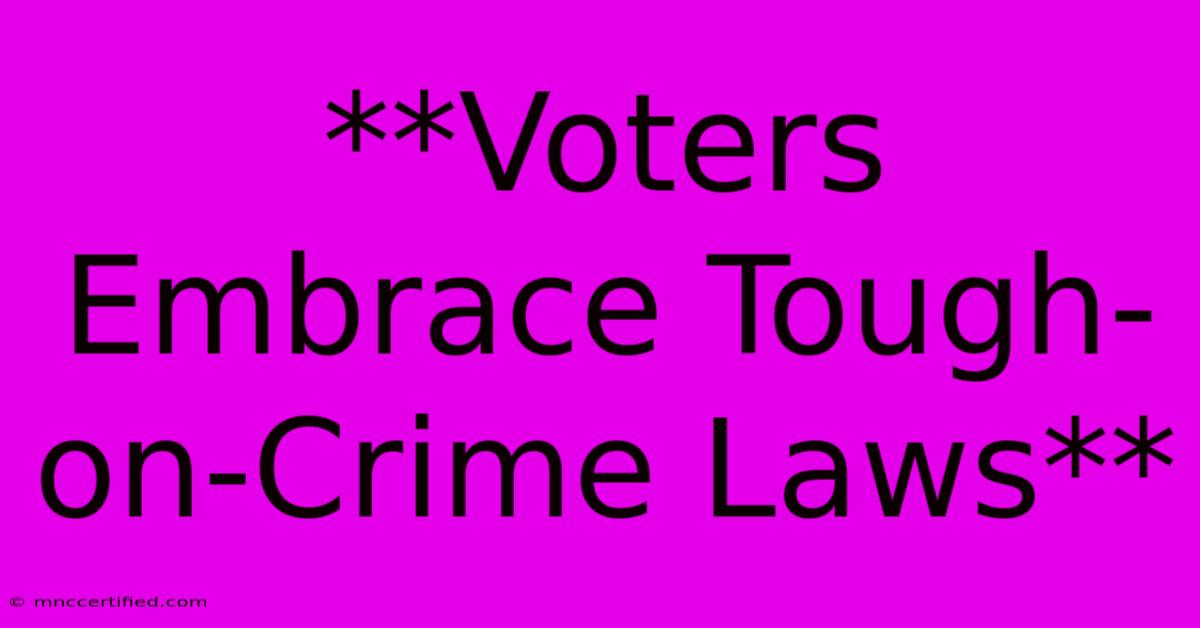**Voters Embrace Tough-on-Crime Laws**

Table of Contents
Voters Embrace Tough-on-Crime Laws: A Shift in Public Sentiment
The pendulum of public opinion on crime policy has swung decisively towards a tough-on-crime stance. This shift, driven by a perceived rise in crime rates and a growing sense of insecurity, has fueled support for stricter law enforcement measures across the country. This article will explore the reasons behind this trend and examine the implications of this shift in public sentiment on criminal justice policy.
The Drivers of Public Sentiment
The rise of tough-on-crime policies is closely tied to public perception. Several factors have contributed to this shift:
- Perceived Increase in Crime: While crime rates have declined overall in recent years, a perception of increased crime persists, particularly in urban areas. This perception, fueled by media coverage and anecdotal evidence, has led to heightened public anxiety about crime.
- Fear of Violence: High-profile violent crimes, often involving firearms, contribute to a sense of vulnerability and a desire for stronger law enforcement. This fear drives demands for harsher sentences and increased police presence.
- Political Rhetoric: Political campaigns often exploit public fears about crime, leading to a polarized debate on criminal justice policy. This rhetoric frequently emphasizes punitive measures and downplays the complexities of crime and its causes.
- Lack of Trust in the Justice System: Some argue that a lack of trust in the justice system, particularly regarding its ability to hold perpetrators accountable, fuels the demand for tougher laws. This distrust can lead to public calls for harsher punishments.
The Implications for Criminal Justice Policy
The embrace of tough-on-crime policies has had significant implications for the criminal justice system:
- Increased Incarceration Rates: Longer sentences, mandatory minimums, and three-strikes laws have led to a dramatic increase in the U.S. prison population, placing a heavy burden on the correctional system and taxpayers.
- Focus on Punishment: The emphasis on punishment has often overshadowed efforts to address the root causes of crime, such as poverty, inequality, and lack of access to education and employment.
- Over-Policing of Minority Communities: Tough-on-crime policies have disproportionately impacted minority communities, leading to concerns about racial bias and over-policing.
- Limited Resources for Rehabilitation: The focus on punishment has often left little room for resources dedicated to rehabilitation programs, which could help reduce recidivism rates and promote public safety.
Moving Forward: A Balanced Approach
The trend towards tough-on-crime policies highlights the need for a balanced approach to criminal justice reform. While public safety is paramount, it is crucial to acknowledge the complexities of crime and the need for evidence-based policies that address both punishment and rehabilitation.
Some key considerations for a balanced approach include:
- Data-Driven Policy: Relying on data and research to guide criminal justice policies is essential for developing effective and equitable solutions.
- Rehabilitation and Reintegration: Investing in programs that address the root causes of crime and support the reintegration of formerly incarcerated individuals can significantly reduce recidivism rates.
- Community Policing: Engaging with communities and building trust between law enforcement and residents is crucial for reducing crime and fostering public safety.
- Addressing Systemic Issues: Tackling issues like poverty, inequality, and lack of access to education and employment can help prevent crime before it occurs.
The tough-on-crime movement reflects a complex interplay of public sentiment, political rhetoric, and societal anxieties. Moving forward, it is crucial to engage in thoughtful dialogue, consider evidence-based solutions, and prioritize a balanced approach to criminal justice reform that prioritizes both public safety and equity.

Thank you for visiting our website wich cover about **Voters Embrace Tough-on-Crime Laws**. We hope the information provided has been useful to you. Feel free to contact us if you have any questions or need further assistance. See you next time and dont miss to bookmark.
Featured Posts
-
Real Estate Investment Association Chicago
Nov 07, 2024
-
Project 2025 Understanding The Right
Nov 07, 2024
-
Election Day Rice Community Votes Strong
Nov 07, 2024
-
Doj Evaluates Trump Case Wind Down
Nov 07, 2024
-
Trump Tweets Boost Bitcoin Price
Nov 07, 2024